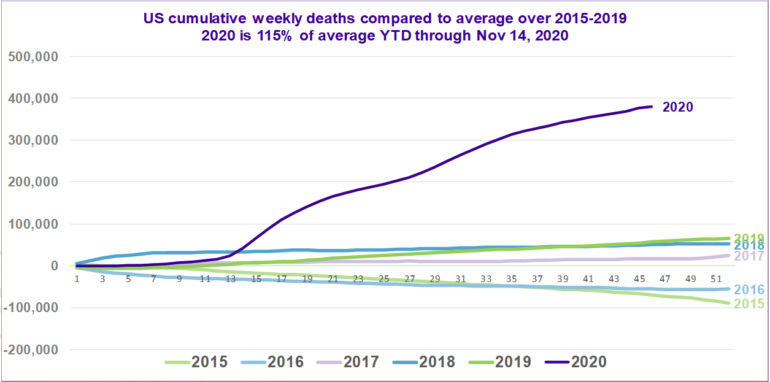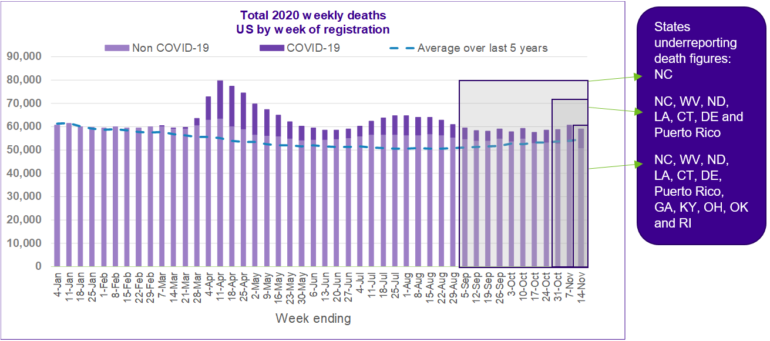This is an update from our August 21, 2020 VitaMins that analyzed state-level excess mortality data at that time.
16 December 2020
Since then, the COVID-19 pandemic has increased the number of COVID-related deaths from over 170,000 to now over 290,000 at the time of writing.
The CDC has come a long way on reporting up to date death data in the US since the start of the pandemic. At the time of writing (December 15, 2020) data for almost all states seem reasonable up to mid-November 2020. There are some states that continue to have significant delays in death reporting. We will present charts for each state through mid-November and you will be able to spot the states with reporting delays.
Current position of the US
The chart below shows the cumulative weekly deaths in the US for each year from 2015, relative to the average over 2015 to 2019. Note that the aging US population means we would expect the number of deaths to increase slightly each year, all else being equal.
The purple line shows the situation up to the end of November 14, 2020. Despite official estimates of 290,000 COVID-related deaths at December 10, we are seeing around 380,000 deaths in excess of the five-year average of deaths occurring in the year by November 14 – and even this estimate is likely to be on the low side, as there are some large states that have not yet reported data for September through November. The period up to November 14 experienced at least 115% of the expected deaths at this point of the year (based on a five-year average).
It’s safe to say we are experiencing an extreme mortality event.

The next chart shows the number of deaths that were registered in the US each week in 2020. The dark purple bars show deaths recorded as COVID-related; the light purple bars show other deaths. The blue dashed line shows the average number of deaths for each week of the year based on the previous five years.
The chart shows more deaths being recorded than the previous average from the end of February. There is a distinct (and high) peak to these ‘excess deaths’ in April, followed by a summer wave and a developing fall wave. We note that this data ends prior to the Thanksgiving holiday in the US that saw many households getting together and contributing to the reported early December spread of the disease.
Another thing we see is that many of these ‘excess deaths’ were not recorded as COVID-related. It seems likely that some of these excess deaths were in fact due to COVID and were not recorded as such. In understanding the true impact of the pandemic on the US, data on excess deaths will give us a more complete picture than deaths recorded as COVID-related.
In reviewing this total chart for the United States, it’s important to note that data on the number of deaths is reported at a state level. Some states have had significant delays in reporting death information to the CDC and therefore any country-wide statistics using this data will be underreporting the overall impact of excess deaths in 2020. The chart below highlights which states appear to have underreporting issues. North Carolina has the longest lag for death reporting. More information on each state can be found in the appendix of this VitaMins.

In this article we will use similar charts to explore how the pandemic has spread across the US and how different states have been affected differently depending on when outbreaks first occurred.
For details of how each state, New York City, District of Columbia and Puerto Rico have been affected differently by COVID-19, including a description of how things have progressed through the country over time, please see our full article.
The source for the data used in this article is the Weekly Counts of Deaths by State published by the Center of Disease Control and Prevention (CDC). Charts for all states, New York City, District of Columbia and Puerto Rico can be found in the appendix.
VitaMins: How different American states have experienced COVID-19 so far
Download the full article



